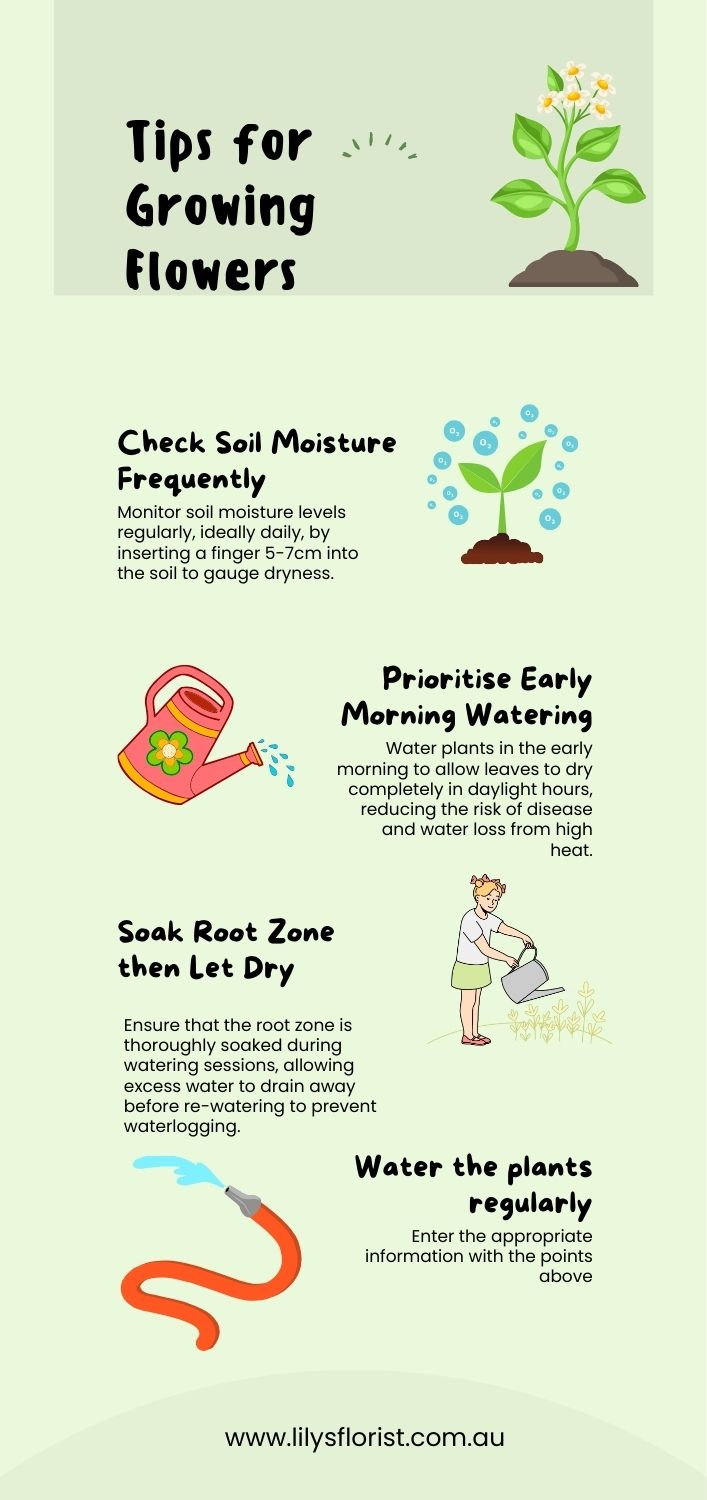Same Day Flowers Delivery - Australia Wide!
Watering Techniques for Different Flowers

At Lily's Florist, we understand that that growing gorgeous, vibrant flowers takes some skill and knowledge. One of the most important things is understanding how to properly water different flower varieties. Not all blossoms have the same hydration needs! Proper watering is key for keeping your floral friends healthy and thriving in the garden or indoor arrangements.
In this beginner's guide, you’ll learn watering basics and tips for specific flower types so you can master moisture levels. We’ll cover how factors like climate, soil, time of day, and more play a role. With the right hydration techniques, your diverse flower collection will wow!
If you would like more tips view our series of blog posts on flower care.
Watering Frequency Guidelines by Flower Type
When figuring out watering techniques, a key question is how often different flowers need hydration. This depends on variables like:
- Climate and environment
- Type of soil
- Stage of growth
- Time of year
But in general, most blossoms fall into these categories for watering frequency:
- Daily: Roses, carnations, zinnias
- 2-3 times per week: Marigolds, pansies, petunias
- Weekly: Orchids, succulents, cacti
Of course, adjust as needed based on extra dry or hot weather. The goal is keeping soil moist but not muddy.
Now let’s explore specific methods and schedules for proper watering by bloom variety.

Roses
As queen of the flowers, roses have special hydration requirements for lush leaves and bright, long-lasting blossoms during their growing season. Here are effective watering techniques:
- Water daily in morning, avoiding leaves
- Soak soil 15-30cm deep
- Add 5-7cm mulch to retain moisture
- Use soaker hoses for deep penetration
If roses wilt easily, increase frequency. But take care not to overwater, which
Water Daily
Water roses every morning, avoiding the leaves
Soak Deeply
Ensure soil is soaked 15-30cm deep
Add Mulch
Apply 5-7cm of mulch to retain moisture
Use Soaker Hoses
Employ soaker hoses for deep penetration
Annuals: Petunias, Marigolds, Zinnias
Annuals like petunias, marigolds and zinnias thrive on frequent, generous watering for nonstop blooms. Try this regime:
- Water when top 5cm of soil is dry
- Target the roots, not leaves or flowers
- Soak thoroughly, then let dry again
- Add thick mulch for moisture retention
- Water in the morning to prevent diseases
Adjust for fast drainage soils by watering more often. Wilting and fewer blossoms indicates under-watering.
Orchids
As tropical epiphyte plants, orchids have specialised watering needs. Follow these best practices:
- Water 1-2 times per week depending on climate
- Soak completely then drain, avoiding crown
- Let orchid dry slightly between waterings
- Increase humidity with pebble trays
- Water in morning so leaves dry by night
If leaves wrinkle or yellow, increase frequency. If roots rot, allow to dry further before watering.
Water Weekly
Water 1-2 times per week, depending on climate
Soak Completely
Soak thoroughly, then drain, avoiding the crown
Allow to Dry
Let orchid dry slightly between waterings
Increase Humidity
Use pebble trays to increase humidity
* Key Watering Tips
Hydrate early, allowing leaves to dry Soak until water drains from holes Add 5-7cm mulch to lock in moisture Avoid excessive heat, wind exposure Check soil daily to gauge dryness Adjust for weather, growth cycles
| Flower | When | How | Notes |
|---|---|---|---|
| Roses | Daily | Soak soil deeply | Mulch to retain water |
| Petunias | When soil dry 1" | Target roots | Use thick mulch |
| Orchids | 1-2x week | Soak completely | Increase humidity |
As you can see, most plants need frequent, thorough watering for vigorous growth and plentiful blooms. But schedules vary, so observe plants closely.
With orchids, wait until almost dry between waterings. Succulents like cacti and jade prefer infrequent but deep soaking.
The most fail-proof way to assess if plants need hydrating? Check soil moisture daily by inserting a finger 5-7cm. Keep the soil moist but not soggy through the root zone. Add bountiful mulch to lock in moisture.
Gerbera Daisies
Native to tropical regions, gerbera daisies require careful watering for their delicate, colorful blooms. Follow these tips:
- Water when the top 5-7cm of soil becomes dry
- Thoroughly soak the soil, then let drain completely
- Avoid getting water on the foliage and flowers
- Water in morning so leaves dry by night
- Use a blooming plant fertiliser to encourage flowering
- In very hot weather, water when top layer feels almost dry
Wilting, drooping leaves or brown leaf edges indicates under-watering. Overwatering causes roots and stems to rot.
Check Soil
Water when top 5-7cm of soil becomes dry
Morning Watering
Water in morning so leaves dry by night
Avoid Foliage
Avoid getting water on foliage and flowers
Adjust for Heat
In hot weather, water when top layer feels almost dry
Lilies
With their regal blooms and sweet fragrance, lilies make a wonderful addition to any garden. But they can be fussy about correct hydration. Try this routine:
- Water when top 7cm of soil become partly dry
- Give a thorough, deep soaking then allow to fully drain
- Add thick mulch around plants to retain moisture
- Avoid watering foliage and flowers
- Increase frequency during growth and hot weather
If leaves turn yellow or droop, improve drainage and water more often.
Check Soil
Water when top 7cm of soil becomes partly dry
Deep Soak
Give a thorough, deep soaking then allow to fully drain
Add Mulch
Add thick mulch around plants to retain moisture
Avoid Foliage
Avoid watering foliage and flowers
Watering Plants: Time of Day Matters
Believe it or not, when you water matters just as much as technique. Why? Because wet foliage for prolonged periods raises disease risk.
The optimal time to hydrate plants is early morning, especially for roses. This allows leaves to dry completely in daylight hours. It also prevents water loss from high heat.
If evening or midday watering can’t be avoided, keep these tips in mind:
- Water at soil level
- Avoid dripping on leaves and flowers
- Ensure adequate air circulation
- Mix in fungicides if disease prone
- Monitor for issues like mildew
Watering when sunlight is intense should be prevented. Harsh afternoon light damages wet leaves. Carefully irrigating lower branches and soil is key.
Perfecting Watering Techniques
Hopefully this overview gave you tips to properly care for all the fabulous flowers in your garden or containers.
While specific hydration techniques differ among plant varieties, some core principles apply across the board:
- Check soil moisture levels frequently
- Prioritise early morning watering
- Thoroughly soak root zone then let dry
- Increase water slowly for adjusted plants
- Use mulch generously to lock in moisture
Following these best practices, along with the frequency guidelines shared earlier, will have your blossoms thriving through every season! We covered proper care for roses, orchids, annuals and more.
With a little attentive care and ideal hydration your flowers will thank you with prolific, jaw-dropping blooms year after year. So get out the hose, watering can or irrigation system and quench that floral thirst!
First published 21.3.24, added more details then published again on 16.7.24.
